BuySellBA
Administrator
In Buenos Aires, 65 formal salaries are needed to buy a two-bedroom property - Ambito Financiero

Source:
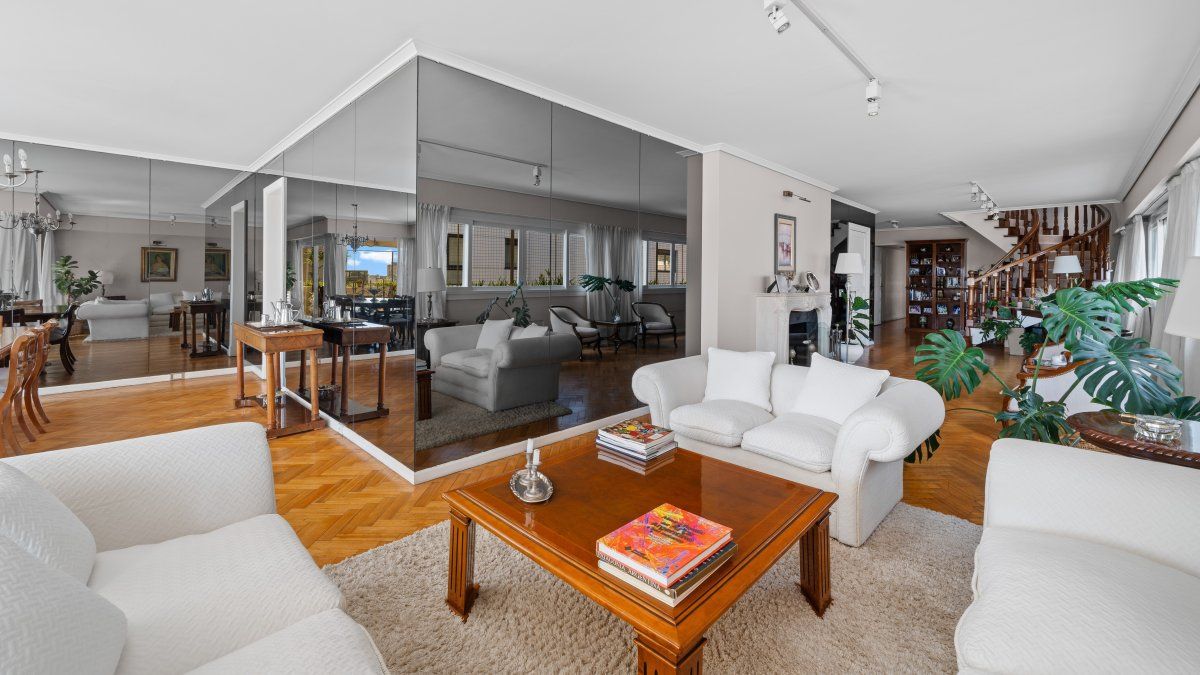
 www.ambito.com
www.ambito.com
October 08, 2025
By Jose Luis Cieri
This was revealed by an analysis by the Buenos Aires College of Auctioneers and UNNOBA. The report revealed the amount required to purchase a standard home.
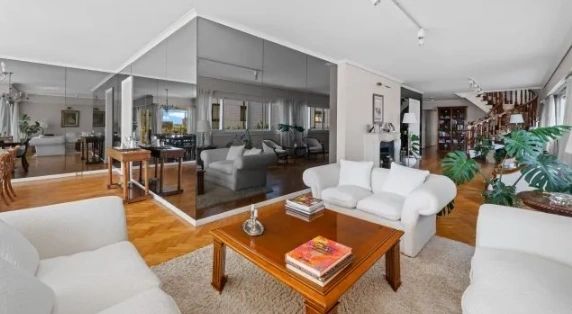
The study, corresponding to the first half of 2025, calculated that the average formal salary in the province was $1,524,216.Martín Pinus Real Estate
In the province of Buenos Aires , a family with a formal income currently needs the equivalent of 65 salaries to buy a typical two-bedroom home . This figure comes from a survey conducted by the College of Auctioneers and Public Brokers of the Province of Buenos Aires in conjunction with the Institute of Politics and Government (IPG) of the National University of the Northwest of the Province of Buenos Aires (UNNOBA), with offices in Junín and Pergamino.
The study, corresponding to the first half of 2025, calculated that the average formal salary in the province was $1,524,216 . Based on that value, to acquire a property worth $68,327 , a household would have to allocate more than five full years of uninterrupted income. The indicator measures the real purchasing power of families in Buenos Aires Province and reflects the loss of purchasing power compared to the cost of housing.
The survey is part of a strategic agreement between the Auctioneers Association and UNNOBA, which seeks to generate high-frequency indicators on real estate activity, buying and selling and rental trends , and market accessibility conditions. The methodology included surveys of real estate agents from the 20 Departmental Judicial Associations and data from official agencies such as INDEC, AFIP, ARBA, and BCRA .
The report determined that 65% of sales transactions in the province correspond to houses and apartments , while land accounts for 21% of the total. The market maintains a predominantly residential profile, with increasing interest in subdivisions and intermediate developments, especially in the province's interior.
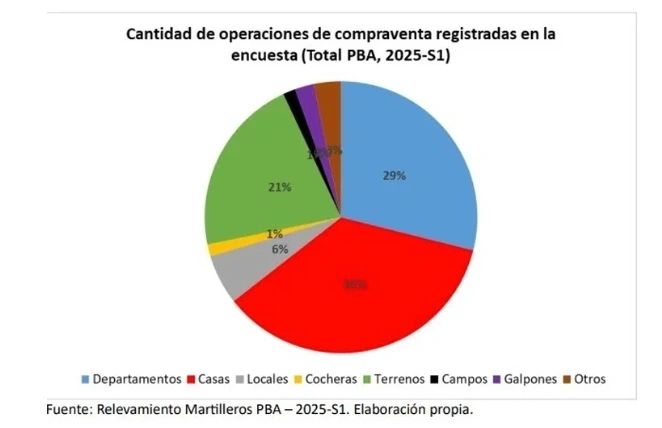
Source: Public Brokers of the Province of Buenos Aires together with the Institute of Politics and Government (IPG) of the National University of the Northwest of the Province of Buenos Aires (UNNOBA)
In terms of rentals, 33% of contracts are for apartments , 31% for houses , and 16% for temporary units . The latter are particularly prevalent in coastal judicial districts, such as Mar del Plata and Necochea.
The report indicates that the average rent is equivalent to 36% of the formal salary , which places many households at the limit of the internationally recommended affordability threshold.
In the districts of the Greater Buenos Aires Metropolitan Area (AMBA), where dense urbanization and industry converge, prices remain high and wages are weak. In contrast, in the Buenos Aires province's interior, with its agro-industrial base and lower demographic pressure, the relationship between income and property values is more balanced.
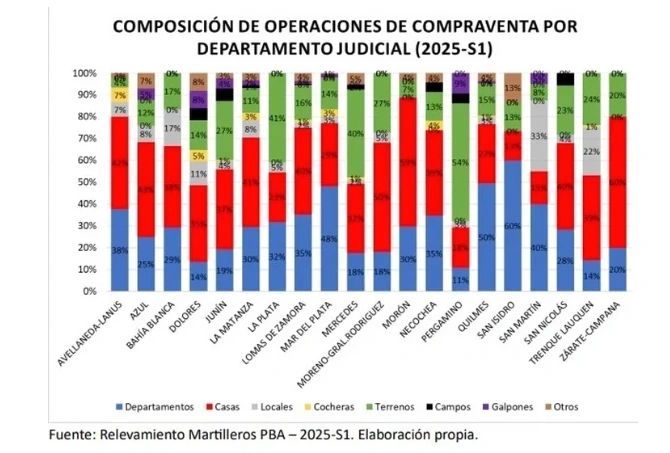
Public Brokers of the Province of Buenos Aires together with the Institute of Politics and Government (IPG) of the National University of the Northwest of the Province of Buenos Aires (UNNOBA)
The study also shows that 67.7% of households in Buenos Aires are homeowners , 18.9% are renters , and the remaining 13.3% live in ceded or occupied housing, which represents a potential for future formalization and expansion of supply.
For Luis Colao , president of the College of Auctioneers and Public Brokers of the Province of Buenos Aires, the results confirm that access to housing continues to be a structural problem. “Today, the market is more stagnant. Mortgage lending has been halted by the banks themselves . Some stopped offering them, and others raised rates, which further complicated affordability,” he explained.
Colao warned that exchange rate volatility also affects operations. He stated: "When the dollar rises, the value of properties in pesos increases, and this limits purchasing power. In recent months, bank financing has once again become concentrated in sectors with high and stable incomes."
Colao emphasized that the continued recovery will depend on the reactivation of credit. “A more flexible and longer-term lending policy is needed. Banks should offer lines with predictable rates and terms commensurate with family income. Without credit, the market cannot grow,” he stated.
The president of the College also referred to the impact of construction costs , which are putting pressure on supply. “The prices of materials and labor have increased and affected the profitability of projects. When costs rise faster than sales prices, developers prefer to wait rather than start new construction,” he noted.
Another aspect highlighted in the report is the province's heterogeneity. The coastal and port areas have mixed economies—tourism, fishing, and energy—while the interior relies on agroindustrial production and intermediate-sized cities. Meanwhile, the suburbs continue to concentrate the bulk of urban activity and the highest population density.
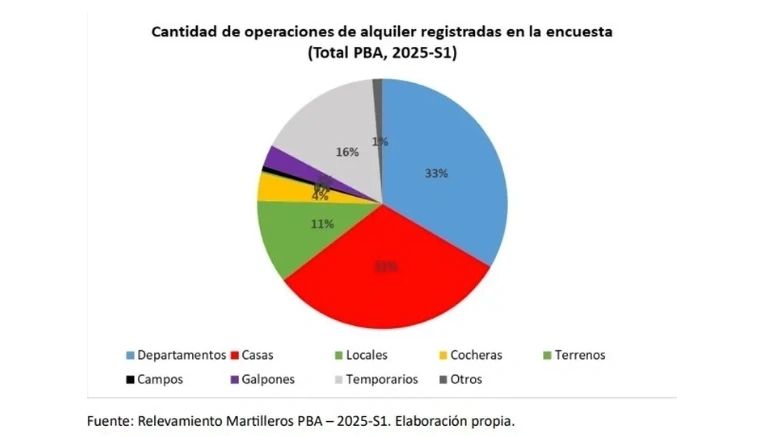
Public Brokers of the Province of Buenos Aires together with the Institute of Politics and Government (IPG) of the National University of the Northwest of the Province of Buenos Aires (UNNOBA)
The document also included a perception survey among industry professionals. The main external factors affecting market performance are the macroeconomic situation (21%) , political stability and security (19%) , credit availability (15%) , and access to public services (14%) . Internal obstacles include a lack of innovation , technological limitations , and difficulty in attracting new customers .
Colao praised the work carried out with the public university and the contributions of the auctioneers from the 20 departmental colleges. "For the first time, we have statistics at the provincial and regional level, not focused on the City of Buenos Aires. These indicators will help us plan and make decisions with concrete information," he explained
The survey will be updated semiannually and aims to establish itself as a benchmark for the Buenos Aires market. The objective, according to Colao, is to have data that guides both industry professionals and public agencies responsible for designing housing policies.
“The challenge is to reduce the gap between wages and housing prices. Today, it takes 65 formal salaries to buy an average home, a gap that can only be narrowed with accessible credit and macroeconomic stability,” Colao concluded.
www.buysellba.com

Source:

En Buenos Aires se necesitan 65 salarios formales para comprar una propiedad de tres ambientes
Así lo reveló un análisis del Colegio de Martilleros bonaerense y la UNNOBA. El informe relevó el dinero que exige una compra de una casa estándar.
October 08, 2025
By Jose Luis Cieri
This was revealed by an analysis by the Buenos Aires College of Auctioneers and UNNOBA. The report revealed the amount required to purchase a standard home.

The study, corresponding to the first half of 2025, calculated that the average formal salary in the province was $1,524,216.Martín Pinus Real Estate
In the province of Buenos Aires , a family with a formal income currently needs the equivalent of 65 salaries to buy a typical two-bedroom home . This figure comes from a survey conducted by the College of Auctioneers and Public Brokers of the Province of Buenos Aires in conjunction with the Institute of Politics and Government (IPG) of the National University of the Northwest of the Province of Buenos Aires (UNNOBA), with offices in Junín and Pergamino.
The study, corresponding to the first half of 2025, calculated that the average formal salary in the province was $1,524,216 . Based on that value, to acquire a property worth $68,327 , a household would have to allocate more than five full years of uninterrupted income. The indicator measures the real purchasing power of families in Buenos Aires Province and reflects the loss of purchasing power compared to the cost of housing.
The survey is part of a strategic agreement between the Auctioneers Association and UNNOBA, which seeks to generate high-frequency indicators on real estate activity, buying and selling and rental trends , and market accessibility conditions. The methodology included surveys of real estate agents from the 20 Departmental Judicial Associations and data from official agencies such as INDEC, AFIP, ARBA, and BCRA .
The report determined that 65% of sales transactions in the province correspond to houses and apartments , while land accounts for 21% of the total. The market maintains a predominantly residential profile, with increasing interest in subdivisions and intermediate developments, especially in the province's interior.

Source: Public Brokers of the Province of Buenos Aires together with the Institute of Politics and Government (IPG) of the National University of the Northwest of the Province of Buenos Aires (UNNOBA)
In terms of rentals, 33% of contracts are for apartments , 31% for houses , and 16% for temporary units . The latter are particularly prevalent in coastal judicial districts, such as Mar del Plata and Necochea.
The report indicates that the average rent is equivalent to 36% of the formal salary , which places many households at the limit of the internationally recommended affordability threshold.
By region
The study also reveals marked differences between regions. In districts such as Necochea (39 salaries) , Dolores (43) , and Mercedes (49) , access to housing is more possible, while in La Plata and Lomas de Zamora, between 82 and 95 salaries are required , and in San Isidro the number rises to 228 , the highest in the province. This gap reflects the inequality in income and property prices between the suburbs and the interior.In the districts of the Greater Buenos Aires Metropolitan Area (AMBA), where dense urbanization and industry converge, prices remain high and wages are weak. In contrast, in the Buenos Aires province's interior, with its agro-industrial base and lower demographic pressure, the relationship between income and property values is more balanced.

Public Brokers of the Province of Buenos Aires together with the Institute of Politics and Government (IPG) of the National University of the Northwest of the Province of Buenos Aires (UNNOBA)
The study also shows that 67.7% of households in Buenos Aires are homeowners , 18.9% are renters , and the remaining 13.3% live in ceded or occupied housing, which represents a potential for future formalization and expansion of supply.
For Luis Colao , president of the College of Auctioneers and Public Brokers of the Province of Buenos Aires, the results confirm that access to housing continues to be a structural problem. “Today, the market is more stagnant. Mortgage lending has been halted by the banks themselves . Some stopped offering them, and others raised rates, which further complicated affordability,” he explained.
Colao warned that exchange rate volatility also affects operations. He stated: "When the dollar rises, the value of properties in pesos increases, and this limits purchasing power. In recent months, bank financing has once again become concentrated in sectors with high and stable incomes."
Positive trend
The survey shows, however, that the provincial market has maintained a positive trend since the second half of 2024, with a recovery in the number of deeds and mortgage loans . In 2025, this improvement continued even with higher rates, and the months of May and July recorded higher levels of activity than in previous years.Colao emphasized that the continued recovery will depend on the reactivation of credit. “A more flexible and longer-term lending policy is needed. Banks should offer lines with predictable rates and terms commensurate with family income. Without credit, the market cannot grow,” he stated.
The president of the College also referred to the impact of construction costs , which are putting pressure on supply. “The prices of materials and labor have increased and affected the profitability of projects. When costs rise faster than sales prices, developers prefer to wait rather than start new construction,” he noted.
Another aspect highlighted in the report is the province's heterogeneity. The coastal and port areas have mixed economies—tourism, fishing, and energy—while the interior relies on agroindustrial production and intermediate-sized cities. Meanwhile, the suburbs continue to concentrate the bulk of urban activity and the highest population density.

Public Brokers of the Province of Buenos Aires together with the Institute of Politics and Government (IPG) of the National University of the Northwest of the Province of Buenos Aires (UNNOBA)
The document also included a perception survey among industry professionals. The main external factors affecting market performance are the macroeconomic situation (21%) , political stability and security (19%) , credit availability (15%) , and access to public services (14%) . Internal obstacles include a lack of innovation , technological limitations , and difficulty in attracting new customers .
Colao praised the work carried out with the public university and the contributions of the auctioneers from the 20 departmental colleges. "For the first time, we have statistics at the provincial and regional level, not focused on the City of Buenos Aires. These indicators will help us plan and make decisions with concrete information," he explained
The survey will be updated semiannually and aims to establish itself as a benchmark for the Buenos Aires market. The objective, according to Colao, is to have data that guides both industry professionals and public agencies responsible for designing housing policies.
“The challenge is to reduce the gap between wages and housing prices. Today, it takes 65 formal salaries to buy an average home, a gap that can only be narrowed with accessible credit and macroeconomic stability,” Colao concluded.
www.buysellba.com

